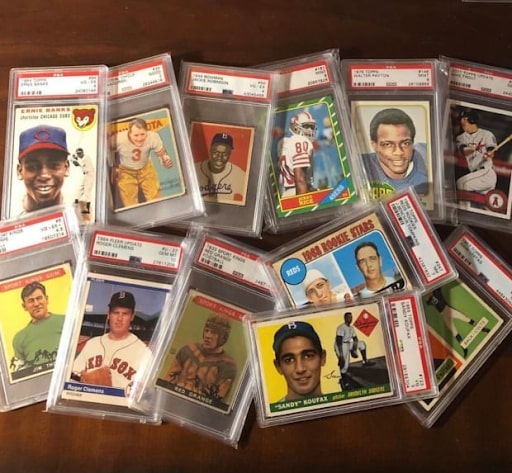If you have a collection of cards that you’ve kept around or that were carefully stashed away in a binder to prevent them from damage, you may question how valuable they are and how to appraise them.
Card grading is the process of evaluating the condition and authenticity of a trading card or collectible card. Card grading aims to determine the card’s condition, which can significantly impact its value and desirability among collectors.
Some card grading services include Beckett (BGS), SGC, CSG, and PSA. The cost varies depending on the grader. PSA, for instance, charges anywhere between $20 and $10,000.
Graded cards are frequently sealed in a tamper-evident casing to prevent damage and are assigned a number grade from 1 to 10, with 10 being the highest and most desirable rating.
Keep reading to learn more!
Key Takeaways
- The objective of card grading is to determine the card’s condition to ascertain its value.
- The criteria for determining a card’s grade include centering, corners, edges, print quality, and authenticity.
- Card grading fees vary based on the grading company. PSA charges range from $20 to $10,000 per card.
- Players can get free grading services through contests and promotions by grading companies, participating in card shows and events, and referral programs.
- Preparing your cards for grading before submitting them helps to increase their value.
Card Grading Criteria
The process of card grading involves thoroughly evaluating a trading card or collectible card to determine its authenticity and condition. The card is typically examined by a professional grader, who will use criteria and standards to assign a grade on a scale of 1 to 10, with 10 being the highest and most desirable. The different levels of grades that can be assigned to a card include the following: Perfect 10: A Perfect 10 is a card having a grade of Pristine 10, with all four subgrades being 10. This “quad 10” is the highest possible card. Under 10x magnification, there are no post-production faults in the four subgrades.
- Perfect 10: A Perfect 10 is a card having a grade of Pristine 10, with all four subgrades being 10. This “quad 10” is the highest possible card. Under 10x magnification, there are no post-production faults in the four subgrades.
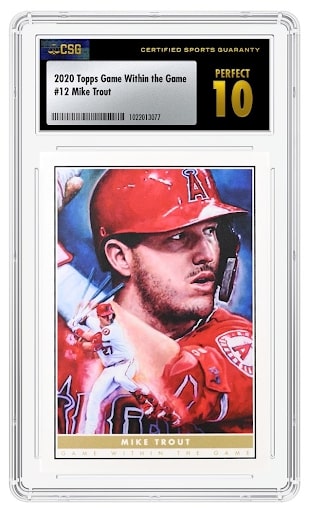
Pristine 10: A Pristine 10 card must be perfectly centered and have no manufacturing or handling flaws. Under 10x magnification, corners will appear flawless to the naked eye, and the surface should be devoid of print spots and have perfect shine.
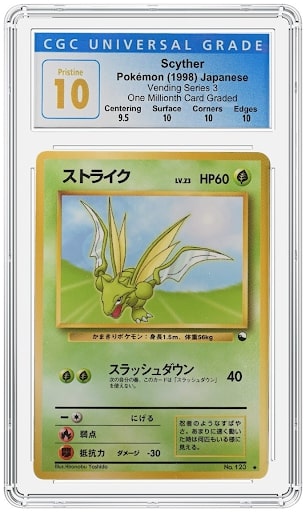
- Gem Mint 9.5: The card will have exceptional centering and minor handling and manufacturing flaws.
- Gem Mint 9: The card has above-average centering and only minor manufacturing or handling flaws.
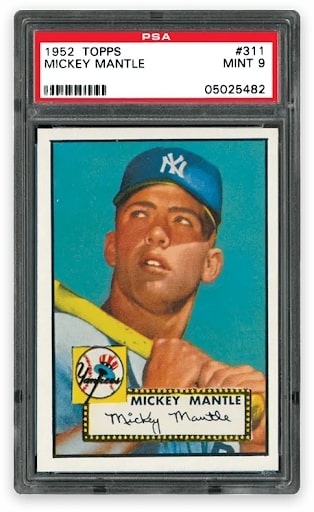
- NM/M+ 8.5: A card whose centering is at least average to above average. The card will exhibit minor handling flaws.
- NM/MT 8: A card in excellent condition with at least average centering and minor to significant handling flaws.
Related: Does PSA Grade Autographed Cards? Yes, And This is the Process
- NM+ 7.5: A card in excellent condition with moderate or minor flaws.
- NM 7: A lightly played card with a strong visual appeal and a mild flaw or several minor flaws.
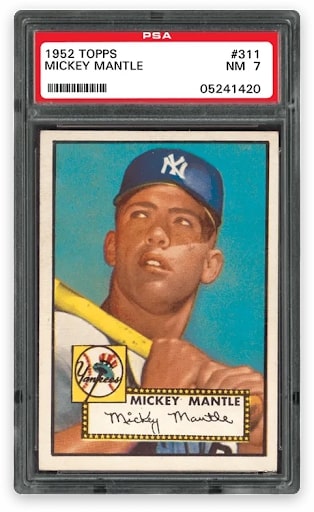
- Ex/NM+ 6.5: A card with minimal scuffing, indents, soiling, or fading.
- Ex/NM 6: A nice and still-bright card. It will contain one moderate flaw and several minor flaws.
- Excellent+ 5.5: A card with decent play. There will be significant and minor flaws.
- Excellent 5: A played card that has moderate and minor flaws. In addition, it may have a light wrinkle.
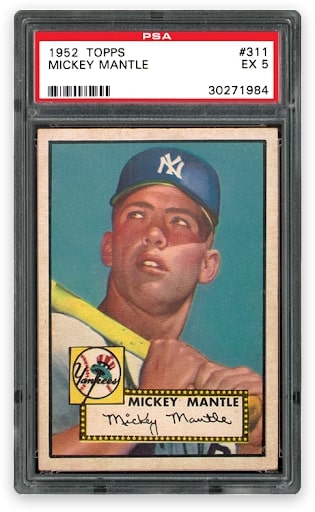
- VG/Ex+ 4.5: A card with apparent signs of usage, including loss of shine and border-wide bleaching.
- VG/Ex 4: A card with heavy wear and moderate flaws, including creases.
Related: How to Become a Sports Card Grader
- Extremely Fine+ 3.5 A frequently used card with a few significant flaws. However, there are no tears.
- Very Good 3 A widely played card with several significant and moderate flaws. These cards usually have no tears.
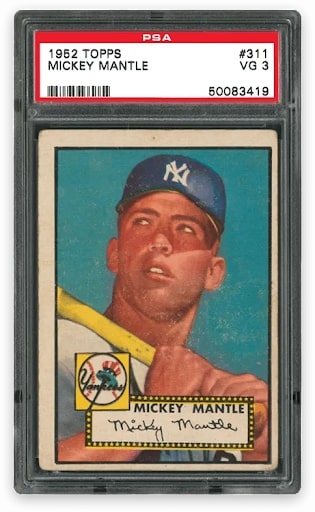
- Good+2.5: A card with considerable flaws, including deep creases and significant discoloration.
- Good 2: A card with inadequate detail and an accumulation of serious flaws resulting from extensive use.
- Fair 1.5: A card with poor visual appeal and severe flaws.
- Poor 1: A card with considerable damage, including big tears and other extreme flaws.

The criteria used to determine a card’s grade include the following:
- Centering: The alignment of the image on the card with respect to the borders.
- Edges: The condition of the borders around the card, including any fraying, chipping, or rounding.
- Corners: The condition of the four corners of the card, including any wear, creasing, or rounding.
- Surface: The condition of the card’s surface, including any scratches, stains, or discoloration.
- Edges: The four edges of a trading card are essential. The edges must be sharp, and the color must be uniform. Imperfect edges have nicks, scratches, or slight discolorations.
- Print quality: The quality of the print on the card, including any blurring, smudging, or fading.
- Authenticity: The card’s authenticity is verified and checked for any signs of tampering or forgery.
It’s important to note that the grading criteria may vary slightly between different card grading services. The final grade assigned to a card is a subjective assessment based on the grader’s professional opinion. Some of the most popular graded cards include:
- Michael Jordan 1989 Hoops All-Star #21
- NBA Graded Card Mystery Booster Pack PSA
- BGS Graded Basketball Card 1986 Fleer Basketball Wax Pack Slabbed PSA Ex-mt 6
Related: How to Organize and Store Your Sports Card Collection
Free Grading Services
To grade Pokémon cards, you must send them to a professional grading company, which examines their condition using the criteria we mentioned earlier. As with any other service, card grading is a paid service. However, there are a few ways to obtain free card grading.
These are:
- Contests and Promotions by Grading Companies
Participating in promotions and contests provided by grading firms is one approach to obtaining free card grading. These promotions and contests are publicized via the grading company’s website, social media, and email newsletters.
PSA (Professional Sports Authenticator) has previously sponsored free grading promotions in which buyers may submit a set number of cards for grading at no cost as long as they match specified criteria.
- Participating in Card Shows and Events
Another way of grading for free is by participating in card shows and events where grading services are offered for free. Grading companies, hobby organizations, or local clubs may organize these events. For example, in the past, SGC (Sportscard Guaranty LLC) has provided free grading services at card shows and conventions.
- Referral Programs
You can also get your card graded for free by participating in the grading companies’ referral programs. Customers can receive free grading services in exchange for referring other customers to the company.
While these opportunities to get cards graded for free may be available, they are typically limited in terms of the number of cards you can submit and are subject to specific requirements and conditions.
Related: Where to Get Cards Graded in Person? Here Are Your Options
Maximizing the Value of Free Grading
Taking advantage of free grading services is a great way to increase the value of your cards without incurring the cost of paid grading services. Preparing your cards for grading will also help increase their value.
Preparing your cards for grading involves several steps, including selecting the right cards to submit, properly packaging and shipping your cards, and understanding the grading criteria used by the grading company.
- Selecting Cards for Grading
When selecting cards for grading, evaluating their condition and potential grade is essential. Cards in excellent or near-mint condition that are in high demand are more likely to obtain a high grade and appreciate in value. Additionally, it is essential to investigate the grading firms and their grading criteria, as different companies may award grades according to different standards.
- Properly Packaging and Shipping Your Cards
Proper packaging and shipping are equally important when preparing your cards for grading. It is crucial to employ durable and secure packaging materials, such as card sleeves, top-loaders, and a solid box to protect your Michal Tech PSA Graded Card Display 5 Pack cards during transportation. It is also essential to correctly mark and mail the box to the grading company.
In addition to these measures, you should be aware of any additional requirements or recommendations of the grading company, such as any forms or documentation that you may need to include with the submission.
Related: How Much Does It Cost to Get a Card Graded by PSA, BGS, and SGC?
How to Get Cards Graded for Free FAQs
- How Much Does It Cost to Have a Card Graded?
PSA grading charges range from $20 to $10,000 per card, depending on the card’s worth, its age, the number of cards you submit at once, the turnaround time you desire, and other considerations.
- What Are the Most Popular Grading Companies?
PSA is the most well-known grading company, followed by Beckett (BGS), SGC, and CSG.
- Is It Worth Getting a Card PSA Graded?
Yes, getting a card PSA graded is worth it. Whether you’re talking about counterfeits or reprints, PSA card grading services are an excellent way to determine the validity of a card.
- Is There an App to Grade Cards?
You can use apps like True Grade App 4+ to grade cards. Individuals can create an account that enables them to photograph their card, grade it on the spot, and store it in a collection for their records. Grading is based on the following criteria:
- Surface
- Centering
- Corners
- Edges
Related: Best Sports Card Packs to Buy in 2023
Conclusion
Card grading is essential for increasing a card’s value and protecting it from damage. There are several grading services available, each with its associated costs. However, it is possible to get cards graded for free through promotions and contests offered by grading companies or by participating in card shows and events where grading services are provided for free.
Research and take advantage of free grading services and properly prepare their cards for grading. That may include researching grading companies and their grading criteria, properly packaging and shipping cards to the grading company, and understanding the grading process and the different levels of grades that can be assigned to a card. By taking the time to properly prepare and submit their cards for grading, collectors can ensure that their cards receive the highest grade possible and increase the value of their collection.

